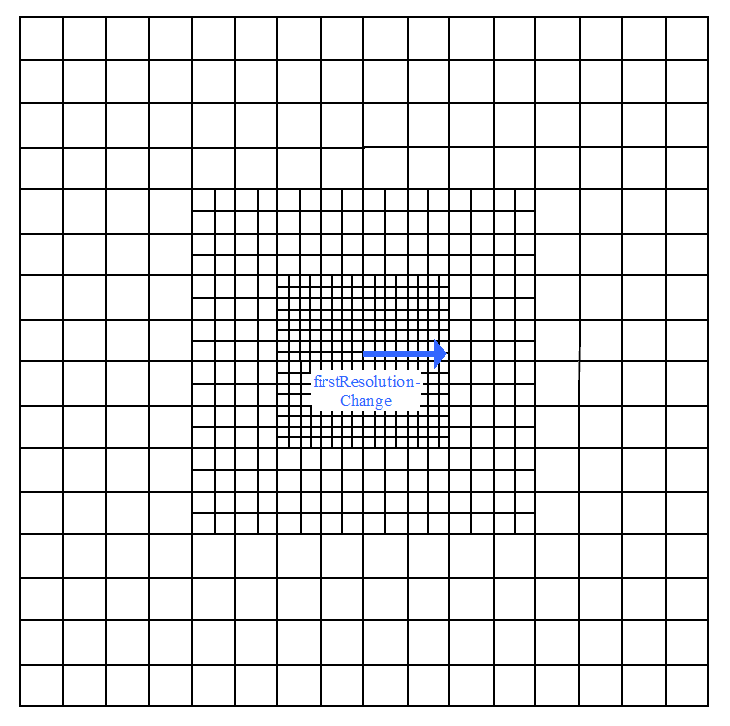VisibilityOperator.FirstResolutionChange Property
Gets or sets a value, telling how far away from the observer that the highest resolution should be used.
Syntax
public AttributeVariable< System.Int64 > FirstResolutionChange { get; set; }Property Value
Default: Differs depending on type. See the table below.
A number of elevation raster cells, telling how far away the highest resolution should be used.
Default values
| Class | Default value |
|---|---|
| AirspaceCoverageOperator | Not used. |
| LineOfSightOperator | 200 |
| TargetLineOfSightOperator | 1500 |
| VisibilityIndexOperator | 200 |
Remarks
Near the observer, the computation will use a basic resolution that is usually the finest resolution available from ElevationInput, although you can choose a coarser basic resolution by using the DesiredInputResolution. Farther away, it is possible to change to resolutions that are coarser than the basic one. The value of FirstResolutionChange is a desired distance from the observer to the first change of resolution, and the value is expressed as a number of elevation raster cells in the basic resolution, instead of a distance in meters.
The second change of resolution will be twice as far away as the first, the third will be four times as far, etc.
 |
To enable multiple resolution, the distance to the first resolution change must be less than the MaxDistance (but the MaxDistance is expressed in meters, so the two numbers are not directly comparable). To get optimal performance, you should ensure that the ElevationInput (and optionally the TreeHeightInput) gives access to a number of pre-built overview resolution levels, with the cell size doubling at each level. This is how the Carmenta Engine raster cache functionality works. See for instance ImageDataSet.RasterCachePolicy for more information.
If the elevation overviews have been created with some other overview division factor, say 3, or if the number of pre-built overviews are too few (or zero), then the operator will automatically resample incoming elevation data to the overview resolutions that it needs. Resampling to pyramidal resolutions on the fly will be slower, especially if pre-built overviews are completely missing. On the other hand, creating pyramidal resolutions on the fly can still be faster than computing in a single, high resolution if the max distance is long, and it will avoid the creation of too large rasters.
The effective value of FirstResolutionChange, as shown in the diagram above, may differ by plus or minus a third from the desired value (the one that is given). This is because the effective value will be chosen so that the computation can use a substantial part of the coarsest raster.
Also, for high-resolution elevations and long ranges, the effective value must not be too small, since the implementation would fail if a raster cell of the coarsest resolution were to become larger than the entire finest raster. In these cases, the operator will automatically raise the effective value to make it safe. For example, if the finest elevation data has 5 m resolution and the range is 180 km, then the operator will ensure that the effective value is at least 284, even if a lower value of FirstResolutionChange has been specified.
Multiple resolution can be used also by a LineOfSightOperator.CustomPropagation object, but if the custom object needs equidistant points in its terrain profiles (see ICustomPropagation.NeedsEquidistantProfilePoints), then the result can get values that are clearly discontinuous at the boundaries between resolutions. If you do not want to rewrite the custom code to accept non-equidistant profiles, you can instead force uniform resolution by letting FirstResolutionChange be a huge value like 999 999 999. And if that slows down the custom calculation too much, you can trade accuracy for speed by making the DesiredInputResolution coarser.
Example
// Decrease FirstResolutionChange by 10
public static void DecreaseFirstResolutionChangeBy10(VisibilityOperator visibilityOperator)
{
// Get the current FirstResolutionChange value
long firstResolutionChangeValue = 0;
visibilityOperator.FirstResolutionChange.TryGetValue(
new AttributeSet(), out firstResolutionChangeValue);
// Check if the current value is larger than 100.
// Because a value in the range 100 - 1500 is recommended.
if (firstResolutionChangeValue <= 100)
{
return;
}
// This property is a member of a type that might be referred to by a View
// or a GlobeView, either directly or indirectly through other objects, which means
// that you must use the Guard class to take the global configuration lock when it
// is modified to synchronize access with any running Carmenta Engine threads.
using (Guard guard = new Guard())
{
// Decrease the FirstResolutionChange by 10
visibilityOperator.FirstResolutionChange = firstResolutionChangeValue - 10;
}
}
Platforms
Windows, Linux, Android